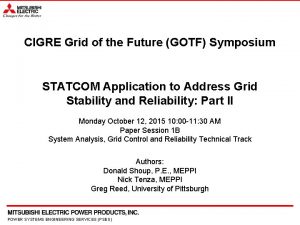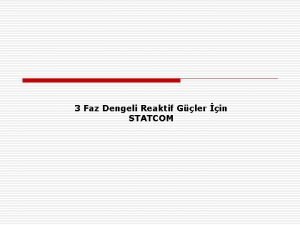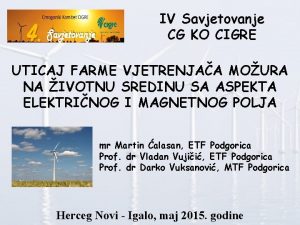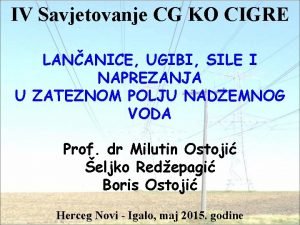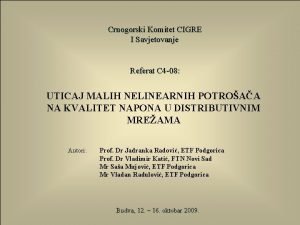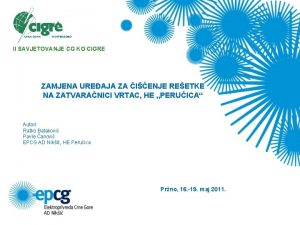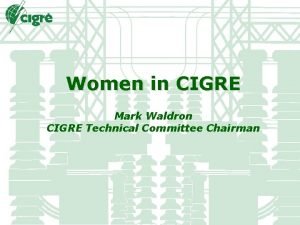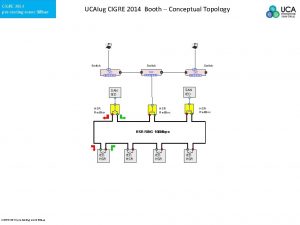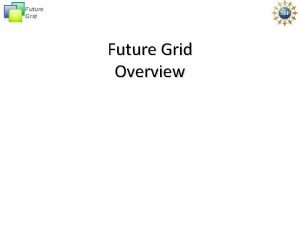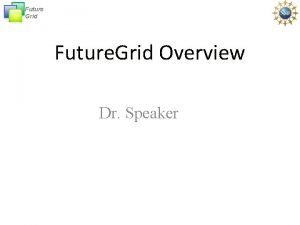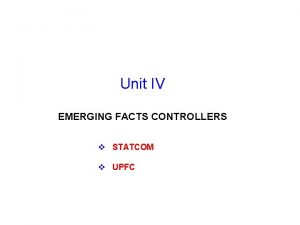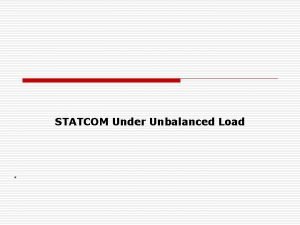CIGRE Grid of the Future GOTF Symposium STATCOM










- Slides: 10

CIGRE Grid of the Future (GOTF) Symposium STATCOM Application to Address Grid Stability and Reliability: Part II Monday October 12, 2015 10: 00 -11: 30 AM Paper Session 1 B System Analysis, Grid Control and Reliability Technical Track Authors: Donald Shoup, P. E. , MEPPI Nick Tenza, MEPPI Greg Reed, University of Pittsburgh POWER SYSTEMS ENGINEERING SERVICES (PSES)

Summary of Part I Ø FACTS and Other Technologies are a Valuable Asset to the Planning Toolbox • • Ø Tools Required are Changing Based on the Continually Changing Landscape of the System and Its Operation • • Ø System changing more rapidly with multi-dimensional challenges Adaptability increasingly important FACTS Have Many Years of Operating Experience • • Ø Use where tradition tools are saturated in use and are not feasible Use to address new concerns driven by changing landscape of system FACTS are used to address rotor angle, frequency, and voltage stability FACTS have been used for 30+ years Studies are Required to Determine the Optimal Solution • • Optimal solution is not obvious and avoid ‘general conceptions’ Optimal solution may be a combination of many technologies POWER SYSTEMS ENGINEERING SERVICES (PSES) FACTS devices are a tool when traditional solutions are saturated in their use, cannot respond quick enough, or an not practical for cycling (repeated operations in short amounts of time)… Plus reasons when constructability, permitting, security, and adaptability are of concern. System strength, loading conditions, and generating conditions/dispatch are all important to consider for evaluating solution options. 2

Summary of Part I (Continued) FACTS accommodate changing generation conditions, i. e. , renewable and intermittent resources, and distributed energy resources that can act as both a load and source. They also are adaptable to various system conditions and are fully controllable to act as the ‘perfect valve’ with prescribed reactive power and real power flows. This capability would also support the ability to address cascading outage conditions. POWER SYSTEMS ENGINEERING SERVICES (PSES) 3

Review of Terminology Ø Rotor angle stability refers to the ability of synchronous machines of an interconnected power system to remain in synchronism after being subjected to a disturbance. (Large and small disturbance initiated events. ) • • Ø Ø Ø Transient instability results from a lack of sufficient synchronizing torque Oscillatory instability (i. e. , power system damping) results from a lack of sufficient damping torque Frequency stability refers to the ability of a power system to maintain steady frequency following a severe system upset resulting in a significant imbalance between generation and load Voltage stability refers to the ability of a power system to maintain steady voltages at all buses in the system after being subjected to a disturbance from a given initial operating condition (Large and small disturbance and long -term and short-term. ) Reliability of a power system refers to the probability of its satisfactory operation over the long run. It denotes the ability to supply adequate electric service on a nearly continuous basis, with few interruptions over an extended time period Adequacy refers to the ability of the power system to supply the aggregate electric power and energy requirements of the customer at all times, taking into account scheduled and unscheduled outages of system components. Security of a power system refers to the degree of risk in its ability to survive imminent disturbances (contingencies) without interruption of customer service. It relates to robustness of the system to imminent disturbances and, hence, depends on the system operating condition as well as the contingent probability of disturbances. Stability of a power system refers to the continuance of intact operation following a disturbance. It depends on the operating condition and the nature of the physical disturbance POWER SYSTEMS ENGINEERING SERVICES (PSES) 4

Study Application Example Ø 20, 000 MW of load pocket Ø 40% of the load is served by remote generation 200 miles away from the load center and is not available for reactive power support Ø Load pocket is expected to continue to have generation retirements because of aging generation plants and clean air legislation Ø Load is expected to continue to increase in the load pocket Ø Of the total load pocket, 40% of the load is estimated to be single-phase residential airconditioner (a/c) motor load. Ø Mechanically Switched Capacitors (MSC) provide compensation on the order of magnitude of one-third of the total load in the region (7000 Mvar). Ø Under-Voltage Load Shedding (UVLS) and Under-Frequency Load Shedding (UFLS) are not used to mitigate short-term voltage stability here. Key Contingency: To Generation Primary Clearing To Generation Hung Breaker Primary Clearing (x 3 Lines) POWER SYSTEMS ENGINEERING SERVICES (PSES) To 138 k. V Backup Clearing To 138 k. V Example 345 k. V Bus x 2 Lines 5

Results POWER SYSTEMS ENGINEERING SERVICES (PSES) 6

Results (Continued) Various Re-Enforcement Options for 10 Cycle Clearing Time POWER SYSTEMS ENGINEERING SERVICES (PSES) 7

Sensitivity Analysis POWER SYSTEMS ENGINEERING SERVICES (PSES) 8

SVC, STATCOM, and Synchronous Condenser Example Dimensions (+250 Mvar): 25 m x 40 m = 1000 m 2 (10, 764 ft 2) Example Dimensions (+300/-100 Mvar): 78 m x 78 m = 6, 084 m 2 (65, 488 ft 2) Above is 100 MVA GCT-Based STATCOM Note the footprint of a STATCOM is reduced by 50% or more than that of an SVC (38 m x 76 m for comparison). POWER SYSTEMS ENGINEERING SERVICES (PSES) 9

Summary Ø Refer to Paper for Table on “Summary of Characteristics Associated with the Solution Options” (note actual characteristics will vary from that given in table) Ø Studies are Required to Determine the Optimal Solution Ø The STATCOM is an effective solution. Of further consideration for the STATCOM solution is the use of new switching technologies such as the Modular Multilevel Converter (MMC), providing lower losses than conventional designs. Continued advancements in semiconductor technology require less semiconductor devices with increased current and voltage ratings than conventional designs. Ø The synchronous condenser provides an alternative solution option with its inherent, initial sub-transient reactive power response to a fault, subsequent ability to provide a transient reactive power response far in excess of its steady state capability, and small footprint. Application of a STATCOM or a synchronous condenser may be a choice between maintaining transmission level interconnected power electronics-based technologies versus rotating machinery. POWER SYSTEMS ENGINEERING SERVICES (PSES) 10
